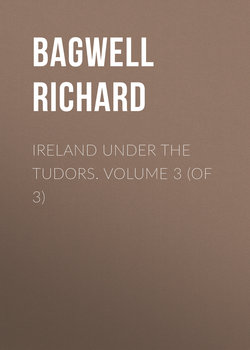Читать книгу Ireland under the Tudors. Volume 3 (of 3) - Bagwell Richard - Страница 1
PREFACE TO THE THIRD VOLUME
ОглавлениеBy a mistake which was not the author’s, the title-pages of its first instalment described this book as being in two volumes. A third had, nevertheless, been previously announced, and this promise is now fulfilled. The Desmond and Tyrone rebellions, the destruction of the Armada, the disastrous enterprise of Essex, and two foreign invasions, have been described in some detail; and even those who speak slightingly of drum and trumpet histories may find something of interest in the adventures of Captain Cuellar, and in the chapter on Elizabethan Ireland.
A critic has said that your true State-paper historian may be known by his ignorance of all that has already been printed on any given subject. If this wise saying be true, then am I no State-paper historian; for the number of original documents in print steadily increases as we go down the stream of time, and they have been freely drawn upon here. But by far the larger part still remains in manuscript, and the labour connected with them has been greater than before, since Mr. H. C. Hamilton’s guidance was wanting after 1592. Much help is given by Fynes Moryson’s history. Moryson was a great traveller, whose business it had been to study manners and customs, who was Mountjoy’s secretary during most of his time in Ireland, and whose brother held good official positions both before and after. Much of what this amusing writer says is corroborated by independent evidence. Other authorities are indicated in the foot-notes, or have been discussed in the preface to the first two volumes. Wherever no other collection is mentioned, it is to be understood that all letters and papers cited are in the public Record Office.
It has not been thought generally necessary to give the dates both in old and new style. The officials, and Englishmen generally, invariably refused to adopt the Gregorian calendar, but the priests, and many Irishmen who followed them, naturally took the opposite course. As a rule, therefore, the chronology is old style, but a double date has been given wherever confusion seemed likely to arise.
It has often been said that religion had little or nothing to do with the Tudor wars in Ireland, but this is very far from the truth. It was the energy and devotion of the friars and Jesuits that made the people resist, and it was Spanish or papal gold that enabled the chiefs to keep the field. This volume shows how violent was the feeling against an excommunicated Queen, and, whether they were always right or not, we can scarcely wonder that Elizabeth and her servants saw an enemy of England in every active adherent of Rome.
At first the Queen showed some signs of a wish to remain on friendly terms with the Holy See, but she became the Protestant champion even against her own inclination. Sixtus V. admired her great qualities, and invited her to return to the bosom of the Church. ‘Strange proposition!’ says Ranke, ‘as if she had it in her power to choose; as if her past life, the whole import of her being, her political position and attitude, did not, even supposing her conviction not to be sincere, enchain her to the Protestant cause. Elizabeth returned no answer, but she laughed.’
The Elizabethan conquest of Ireland was cruel mainly because the Crown was poor. Unpaid soldiers are necessarily oppressors, and are as certain to cause discontent as they are certain to be inefficient for police purposes. The history of Ireland would have been quite different had it been possible for England to govern her as she has governed India – by scientific administrators, who tolerate all creeds and respect all prejudices. But no such machinery, nor even the idea of it, then existed, and nothing seemed possible but to crush rebellion by destroying the means of resistance. It was famine that really ended the Tyrone war, and it was caused as much by internecine quarrels among the Irish as by the more systematic blood-letting of Mountjoy and Carew. The work was so completely done that it lasted for nearly forty years, and even then there could have been no upheaval, but that forces outside Ireland had paralysed the English Government.
My best thanks are due to the Marquis of Salisbury for his kindness in giving me access to the treasures at Hatfield, and to Mr. R. T. Gunton for enabling me to use that privilege in the pleasantest way.
Marlfield, Clonmel,
March 17, 1890.
